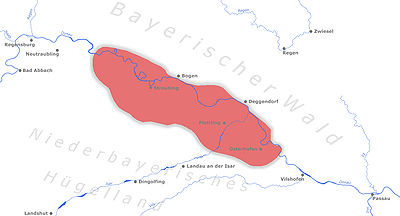Gäuboden
The Gäuboden or Dungau is a region of Lower Bavaria with not clearly defined geographical and cultural borders, which stretches for a width of about 15 kilometers south of the Danube and the Bavarian Forest , starting down the Danube opposite Wörth on the Danube and reaching to Künzing . The largest city in the Gäuboden is Straubing , which is often referred to as the center of the Gäuboden. The Gäuboden is one of the largest loess areas in southern Germany.
Geography and geology

The area and boundaries of the Gäuboden are not precisely defined. The various information that can be found in the literature, however, agree on the following points:
- the Gäuboden is located in the Danube plain,
- on the left side of the Danube, the Gäuboden is bounded by the Bavarian Forest,
- on the right side of the Danube it is bounded by the Danube-Isar-Hügelland and Isar-Inn-Hügelland .
The south-eastern border is to be defined relatively clearly, as the Danube plain narrows between Osterhofen and Vilshofen. Künzing or Pleinting are usually mentioned as border towns . The north-western border, however, varies significantly more: If Regensburg is sometimes referred to as part of the Gäuboden, the beginning of the Gäuboden is roughly on the border between the administrative districts of Lower Bavaria and Upper Palatinate , near Wörth on the Danube and Pfatter .
Due to the mineral-rich, well-aerated loess layers , fertile and relatively easy-to-work soils were able to form in this Danube plain . In connection with the Gäuboden, one often speaks of the "breadbasket of Bavaria". Because of the prosperity around 1900 people also spoke of "peasant kings". In addition to the classic types of grain and potatoes , maize and sugar beet are also grown in this “agricultural steppe” (sugar factories in Plattling and, until autumn 2007, in Regensburg ).
The Gäuboden in literature
Since the loess area begins after Regensburg and ends before Vilshofen on the Danube ( Pleintinger Enge), one could also specify these limits for the Gäuboden, and one actually finds somewhat different information in the literature. For example, FJ Bronner speaks in Bayerisch Land und Volk (around 1900) of the “fertile plain that stretches from Regensburg to Osterhofen ”, that is, compared to today's tradition, the Gäuboden would be shifted 10 to 20 kilometers up the Danube.
In 1784 Johann Pezzl described the Dungau in his journey through the Baierschen district as
- so-called Tunka, in the common Bavarian national language, dark floor. This is the name of the large, uninterrupted cornfield that stretches from the Straubingen area to Regensburg. This is one of the richest stretches of Lower Bavaria in the country, and the peasants on it are famous everywhere among their compatriots as wealthy men .
Emergence
Fundamental for the development of the Gäuboden was the uplift of the Alps with an accompanying depression that extended northwards to the much older Bavarian Forest. A natural monument of old elevations that sank is, for example, the Natternberg south of Deggendorf . During the last Ice Age ( Worm Ice Age ), storms from largely poorly vegetated landscapes blew a lot of calcareous dust into the lower Gäuboden, from which loess, up to six meters thick, was formed. Since about 5500 BC The Gäuboden is settled and used for agriculture.
Weather and climate
Because of its low location ( 320 m above sea level ) and because it is protected from violent winds in the north by the Bavarian Forest and in the south by the Lower Bavarian hill country, the Gäuboden has a mild and relatively low-precipitation climate, but with a strong tendency towards fog formation in spring and autumn.
|
Average temperature and precipitation values
Source: MSN Weather
|
||||||||||||||||||||||||||||||||||||||||||||||||||||||||||||||||||||||||||||||||||||||||||||||||||||||||||||||||||||||||||||||||||||||||||||||||||||||
Flora and fauna
Despite the intensive agricultural use, the Gäuboden still offers a habitat for many rare plant and animal species. In the area of backwaters different come pondweed before species, to water lilies , water pen , Common Frog bite and crab claw . Siberian iris , primrose , low salsify , common adder's tongue and mosquito handelwort can be found in meadows . Semiarid grassland are of rare orchid species as military orchid , fire orchid , 's Small orchid , Bug orchid , Zweiblättriger butterfly orchid , pyramid Hundswurz and other plants such as rosemary-daphne and Spring Gentian inhabited. In the few remnants of oak and hornbeam forests, the Turkish league occurs , while the common occurrence of the sour cherry is noticeable in the small areas of pine forests .
The sea frog has a regional focus in the area of the Danube. In an investigation in 1976, 26 fish species were found in the Danube near Vilshofen, and 19 in Straubing. In the area between Niederachdorf and Vilshofen, 252 bird species were found between 1900 and 1977, 159 of which were found to be breeding birds. The bluethroat , the curlew and the redshank are among the special features.
See also
literature
- Franz X. Bogner: The Gäuboden from the air. Attenkofer, Straubing 2014, ISBN 978-3-942742-20-7 .
- Franz Krojer: Exposure of the Gäuboden. Difference, Munich 2006.
- Erwin Rutte: Rhine - Main - Danube. A geological story. Thobecke, Sigmaringen 1987, ISBN 3-7995-7045-4 .
- Dieter Vogel (Ed.): The Gäuboden. Homeland book. Kiebitz book, Vilsbiburg 1996, ISBN 3-9804048-2-X .
- Bavarian State Office for Environmental Protection. Ornithological Working Group East Bavaria: Habitat Danube Valley. Results of an ornitho-ecological study between Straubing and Vilshofen , Munich, Vienna, R. Oldenbourg Verlag, 1978 (series of publications on nature conservation and landscape conservation, issue 11), ISBN 3-486-22921-4

